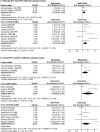Intimate partner violence and HIV infection among women: a systematic review and meta-analysis
- PMID: 24560342
- PMCID: PMC3925800
- DOI: 10.7448/IAS.17.1.18845
Intimate partner violence and HIV infection among women: a systematic review and meta-analysis
Abstract
Introduction: To assess evidence of an association between intimate partner violence (IPV) and HIV infection among women.
Methods: Medline/PubMed, Embase, Web of Science, EBSCO, Ovid, Cochrane HIV/AIDS Group's Specialized Register and Cochrane Central Register of Controlled Trials were searched up to 20 May 2013 to identify studies that examined the association between IPV and HIV infection in women. We included studies on women aged ≥15 years, in any form of sexually intimate relationship with a male partner.
Results: Twenty-eight studies [(19 cross-sectional, 5 cohorts and 4 case-control studies) involving 331,468 individuals in 16 countries - the US (eight studies), South Africa (four studies), East Africa (10 studies), India (three studies), Brazil (one study) and multiple low-income countries (two studies)] were included. Results were pooled using RevMan 5.0. To moderate effect estimates, we analyzed all data using the random effects model, irrespective of heterogeneity level. Pooled results of cohort studies indicated that physical IPV [pooled RR (95% CI): 1.22 (1.01, 1.46)] and any type of IPV [pooled RR (95% CI): 1.28 (1.00, 1.64)] were significantly associated with HIV infection among women. Results of cross-sectional studies demonstrated significant associations of physical IPV with HIV infection among women [pooled OR (95% CI): 1.44 (1.10, 1.87)]. Similarly, results of cross-sectional studies indicated that combination of physical and sexual IPV [pooled OR (95% CI): 2.00 (1.24, 3.22) and any type of IPV [pooled OR (95% CI): 1.41 (1.16, 1.73)] were significantly associated with HIV infection among women.
Conclusions: Available evidence suggests a moderate statistically significant association between IPV and HIV infection among women. To further elucidate the strength of the association between IPV and HIV infection among women, there is a need for high-quality follow-up studies conducted in different geographical regions of the world, and among individuals of diverse racial/cultural backgrounds and varying levels of HIV risks.
Keywords: HIV/AIDS; gender-based violence; intimate partner violence; meta-analysis; systematic review; women's health.
Figures



Comment in
-
The perils of conducting meta-analyses of observational data.J Int AIDS Soc. 2014 Jun 9;17(1):19112. doi: 10.7448/IAS.17.1.19112. eCollection 2014. J Int AIDS Soc. 2014. PMID: 24915989 Free PMC article. No abstract available.
References
-
- World Health Organization. Primary prevention of intimate-partner violence and sexual violence. Background paper for WHO expert meeting; 2007. [cited 2013 Nov 19]. Available from: http://www.who.int/violence_injury_prevention/publications/violence/IPV-....
-
- Murray CJ, Vos T, Lozano R, Naghavi M, Flaxman AD, Michaud C, et al. Disability-adjusted life years (DALYs) for 291 diseases and injuries in 21 regions, 1990–2010: a systematic analysis for the Global Burden of Disease Study 2010. Lancet. 2012;380(9859):2197–223. - PubMed
-
- Watts C, Zimmerman C. Violence against women: global scope and magnitude. Lancet. 2002;359:1232–7. - PubMed
-
- United States Agency for International Development (USAID) Washington, DC: Interagency Gender Working Group; 2006. Addressing gender-based violence through USAID's Health Programs: a guide for health sector program officers.
-
- Heise L, Raikes A, Watts C, Swi A. Violence against women: a neglected public health issue in less developed countries. Soc Sci Med. 1994;39:1165–78. - PubMed
Publication types
MeSH terms
LinkOut - more resources
Full Text Sources
Other Literature Sources
Medical

